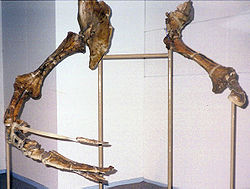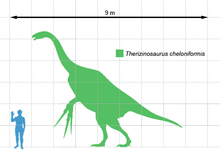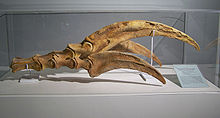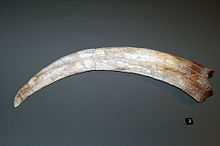
Therizinosaurus
Background to the schools Wikipedia
This wikipedia selection has been chosen by volunteers helping SOS Children from Wikipedia for this Wikipedia Selection for schools. Sponsor a child to make a real difference.
| Therizinosaurus Temporal range: Late Cretaceous, 70Ma |
|
|---|---|
 |
|
| Fossil forelimbs, Experimentarium, Denmark | |
| Scientific classification |
|
| Kingdom: | Animalia |
| Phylum: | Chordata |
| Class: | Reptilia |
| Order: | Saurischia |
| Superfamily: | †Therizinosauroidea |
| Family: | †Therizinosauridae |
| Genus: | †Therizinosaurus Maleev, 1954 |
| Species: | † T. cheloniformis |
| Binomial name | |
| Therizinosaurus cheloniformis Maleev, 1954 |
|
Therizinosaurus (pron.: / θ ɛ ˌ r ɪ z ɨ n ɵ ˈ s ɔr ə s /; 'scythe lizard', from the Greek therizo meaning 'to reap' or 'to cut off' and sauros meaning 'lizard') is a genus of very large theropod dinosaurs. Therizinosaurus comprises the single species T. cheloniformis, which lived in the late Cretaceous Period (late Campanian-early Maastrichtian stages, around 70 million years ago), and was one of the last and largest representatives of its unique group, the Therizinosauria. Fossils of this species were first discovered in Mongolia and were originally thought to belong to a turtle-like reptile (hence the species name, T. cheloniformis — "turtle-formed"). It is known only from a few bones, including gigantic hand claws, from which it gets its name.
Description
Though the fossil remains of Therizinosaurus are incomplete, inferences can be made about their physical characteristics based on related therizinosaurids. Like other members of their family, Therizinosaurus probably had small skulls atop long necks, with bipedal gaits and heavy, deep, broad bodies (as evidenced by the wide pelvis of other therizinosaurids). Their forelimbs may have reached length of up to 2.5 metres (8 feet) or even 3.5 metres in the largest known specimen. Their hindlimbs ended in four weight-bearing toes, unlike other theropod groups, in which the first toe was reduced to a dewclaw. Gregory S. Paul in 2010 estimated the maximum size of Therizinosaurus at ten metres in length and five tonnes in weight. They are the largest therizinosaurs known, and the largest known maniraptorans.
The most distinctive feature of Therizinosaurus was the presence of gigantic claws on each of the three digits of their frontlimbs. These were common among therizinosaurs but especially large in Therizinosaurus, and while the largest claw specimens are incomplete, they probably reached just under 1 metre (3.28 ft) in length. The claws are the longest known from any animal. The claws were relatively straight, only gradually tapering into a point, and extremely narrow, transversely flattened.
The feeding habits of Therizinosaurus are unknown, since no skull material has ever been found that could indicate their diet. However, like other therizinosaurs, they were probably primarily herbivorous.
History
The first fossil remains of Therizinosaurus were discovered in 1948 by a joint Soviet-Mongolian fossil expedition, in the Nemegt Formation of southwestern Mongolia. The expedition unearthed several giant claws that measured, including presumed horn sheaths, up to a meter in length. These were named and described by Russian paleontologist Evgeny Maleev in 1954, who thought they belonged to a large diving turtle-like reptile, 4.5 metres long, that used the claws to harvest seaweed. The holotype specimen, PIN no. 551-483, consisted of the claws. However, it was not understood what general kind of creature these belonged to until 1970, when Anatoly Konstantinovich Rozhdestvensky determined it to be a theropod dinosaur and not a turtle. Nevertheless, what precise kind of dinosaur it was remained a controversial issue. Some reconstructed it with a head and body like a carnosaur and a killing claw on the foot like a deinonychosaur.
Further expeditions unearthed more fossils. The first were specimens IGM 100/15-17: several more sets of claws and parts of the forelimbs, described by Rinchen Barsbold in 1976. Another find was specimen IGM 100/45, consisting of hindlimbs, described by Altangerel Perle in 1982. Subsequently, finds in northern China of related species allowed paleontologists to assemble the general skeletal structure of the animal. The discovery that these enigmatic segnosaurs (including Erlikosaurus and Segnosaurus) were actually theropods helped clarify the relationships of Therizinosaurus. Various theories had been proposed to explain the ancestry of the "segnosaurids," with some scientists suggesting they were descendants of the sauropodomorphs or even that they were neither saurischians nor ornithischians - but new, well-preserved finds such as Alxasaurus in 1993 and Beipiaosaurus in 1996 provided details about the bird-like pelvis, feet and skulls of primitive members, and helped confirm that segnosaurids belonged to the same group of theropod dinosaurs as Therizinosaurus (and were therefore renamed therizinosaurids), and that therizinosaurs were, more specifically, advanced, herbivorous maniraptoran theropods.
Phylogeny
Therizinosaurus was in 1954 by Maleev assigned to the Therizinosauridae, seen by him as a unique Central-Asian family of sea-turtles, the largest known. Later the Therizinosauridae were identified with the Segnosauridae, the former name having priority. Relationships within the Therizinosauridae are difficult to determine, other therizinosaurids apart from Segnosaurus and Erlikosaurus being the earlier Nanshiungosaurus and Nothronychus.



